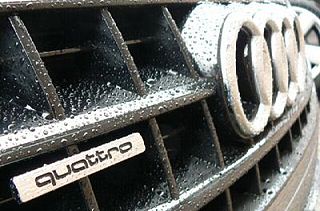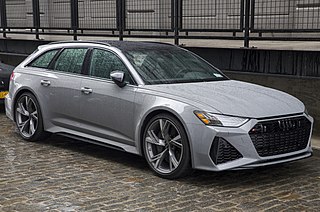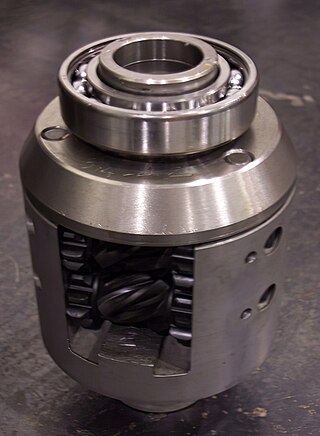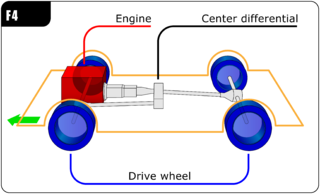
Four-wheel drive, also called 4×4 or 4WD, refers to a two-axled vehicle drivetrain capable of providing torque to all of its wheels simultaneously. It may be full-time or on-demand, and is typically linked via a transfer case providing an additional output drive shaft and, in many instances, additional gear ranges.

Quattro is the trademark used by the automotive brand Audi to indicate that all-wheel drive (AWD) technologies or systems are used on specific models of its automobiles.

The Mercedes-Benz GLE, formerly Mercedes-Benz M-Class, is a mid-size luxury SUV produced by the German manufacturer Mercedes-Benz since 1997. In terms of size, it is slotted in between the smaller GLC and the larger GLS, the latter with which it shares platforms.

The Audi RS 6 is a high-performance variant of the Audi A6 range, produced by the high-performance subsidiary company Audi Sport GmbH, for its parent company Audi AG, a subsidiary of the Volkswagen Group, from 2002 onwards.

Torsen Torque-Sensing is a type of limited-slip differential used in automobiles.

The Mercedes-Benz W210 was the internal designation for a range of executive cars manufactured by Mercedes-Benz and marketed under the E-Class model name in both sedan/saloon (1995–2002) and station wagon/estate (1996–2003) configurations. W210 development started in 1988, three years after the W124's introduction.
ATTESA is a four-wheel drive system used in some automobiles produced by the Japanese automaker Nissan, including some models under its luxury marque Infiniti.

The Mercedes-Benz C-Class (W204) is the third generation of the Mercedes-Benz C-Class. It was manufactured and marketed by Mercedes-Benz in sedan/saloon (2007–2014), station wagon/estate (2008–2014) and coupé (2011–2015) bodystyles, with styling by Karlheinz Bauer and Peter Pfeiffer.

Super Select is the brand name of a four-wheel drive system produced by Mitsubishi Motors, used worldwide except for North America, where it was initially known as Active-Trac. It was first introduced in 1991 with the then-new second generation of the Mitsubishi Pajero.
ControlTrac four-wheel drive is the brand name of a selectable automatic full-time four-wheel drive system offered by Ford Motor Company. The four-wheel drive system was designed and developed at BorgWarner under its TorqTransfer Systems division in the mid 1980s. BorgWarner calls the system Torque-On-Demand (TOD). ControlTrac was the first automatic system to use software control and no planetary or bevel geared center differential. Instead of a planetary or bevel geared center differential, the system uses a variable intelligent locking center multi-disc differential.

In automotive design, an F4, or front-engine, four-wheel drive (4WD) layout places the internal combustion engine at the front of the vehicle and drives all four roadwheels. This layout is typically chosen for better control on many surfaces, and is an important part of rally racing, as well as off-road driving. In terms of racing purposes, whether it be on-road or off-road, can be described as follows,
A team that pursues the Weak LS4WD architecture will minimize the development cost of the front-wheel drive system at the expense of having a larger rear powertrain. The Weak architecture produces a vehicle with a large powersplit between the front and rear powertrains, while the Strong architecture recommends a vehicle with more similar power and torque requirements for the front and rear.
All Wheel Control (AWC) is the brand name of a four-wheel drive (4WD) system developed by Mitsubishi Motors. The system was first incorporated in the 2001 Lancer Evolution VII. Subsequent developments have led to S-AWC (Super All Wheel Control), developed specifically for the new 2007 Lancer Evolution. The system is referred by the company as its unique 4-wheel drive technology umbrella, cultivated through its motor sports activities and long history in rallying spanning almost half a century.

The Mercedes-Benz CLA class is a series of luxury compact executive cars manufactured by Mercedes-Benz since 2013. The first generation was a four-door sedan based on the platform of the W176 A-Class and W246 B-Class compact cars, marketed as a four-door coupé. In 2015, Mercedes-Benz expanded the CLA family to include the Shooting Brake, a station wagon configuration. As the V177 A-Class sedan took its place as the budget-conscious sedan, the second generation got longer and wider than the W205 C-Class.

The Symmetrical All-Wheel Drive is a full-time four-wheel drive system developed by the Japanese automobile manufacturer Subaru. The SAWD system consists of a longitudinally mounted boxer engine coupled to a symmetrical drivetrain with equal length half-axles. The combination of the symmetrical layout with a flat engine and a transmission balanced over the front axle provides optimum weight distribution with low center of gravity, improving the steering characteristics of the vehicle. Ever since 1986, most of the Subaru models sold in the international market are equipped with the SAWD system by default, with the rear wheel drive BRZ and kei cars as the exceptions.

The Mercedes-Benz W205 is the fourth generation of the Mercedes-Benz C-Class which was produced by Daimler AG between 2014 and 2021. The W205 C-Class was preceded by the W204 C-Class and superseded by the W206 C-Class. The fourth-generation C-Class was available in sedan (W205), station wagon/estate (S205), coupe (C205), cabriolet (A205) and long-wheelbase sedan (V205) body styles.

The W213 Mercedes-Benz E-Class is the fifth-generation of the Mercedes-Benz E-Class. Sold from 2016, it is the successor to the W212/S212 E-Class models. The coupe/convertible models share the same platform as the sedan/wagon, in contrast to the previous generation. The high-performance Mercedes-AMG E 63 and E 63 S versions of the W213 have been available as well from 2016, and these are the only versions with V8 engines.

The Mercedes-AMG GT 4-Door Coupé is an executive car (E-segment) introduced in 2018 by Mercedes-AMG. It is marketed as a five-door variant of the AMG GT two-door sports car. Despite the name and style, the GT 4-Door Coupé is closely related to E63 wagon with its performance chassis, and is featured by the AMG-specific rear frame and a different front axle for better kinematics.

The C257 Mercedes-Benz CLS is the third generation of the CLS range of four-door sedan, and was launched in 2018 as the successor to the Mercedes-Benz CLS (C218). It is only available as a sedan, with no plans to introduce a Shooting Brake variant in the near future. It is based heavily on the E-Class (W213).

The Mercedes-Benz A-Class(W177) is the fourth and current generation of the A-Class range of subcompact executive hatchbacks and sedans. It was launched in 2018 as the successor to the W176 A-Class, with sales commencing in March 2018. The available body styles include:

The Mercedes-Benz W206 is the fifth generation of the Mercedes-Benz C-Class which is produced by Mercedes-Benz Group AG since 2021. It replaces the W205 C-Class which has been produced since 2014. The fifth-generation C-Class is available in sedan (W206), station wagon/estate (S206), and long-wheelbase sedan (V206) body styles. The W206 C-Class is based on the Mercedes MRA II rear-wheel drive modular platform also used by the W223 S-Class.

















